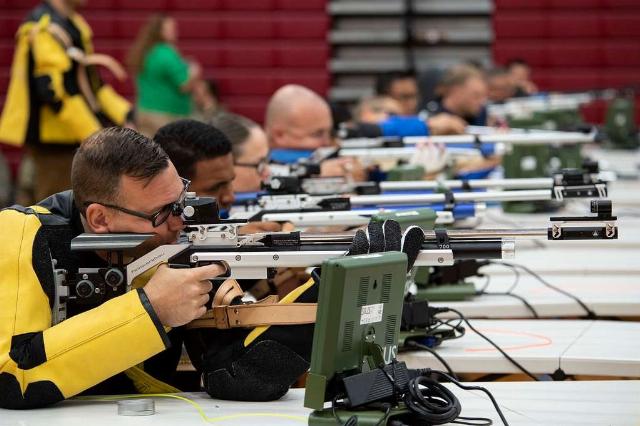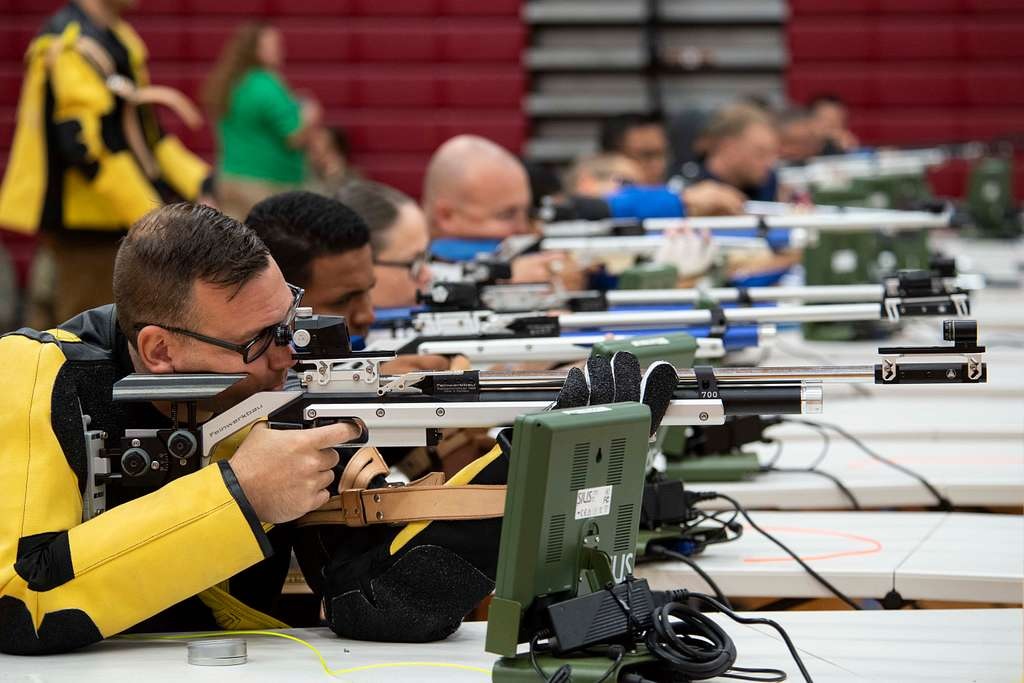

Picryl
Most of us grow up believing that the only place to access expert firearms training is in the military or law enforcement, but that is not the case.Tactical shooting, sometimes known as action pistol or practical shooting, is a firearms discipline that involves shooting at targets in simulated self-defense or combat scenarios. The United States Practical Shooting Association (USPSA) is the largest tactical shooting organization in the United States with over 37,000 active members. At USPSA competitions, members “engage in dynamic and challenging courses of fire, where speed, accuracy, and power are equally tested” (USPSA). The International Defensive Pistol Association (IDPA), based in Bogata, Texas, is an organization that emphasizes the skills associated with self-defense and concealed carry scenarios. IDPA boasts a membership of over 25,000, representing all 50 states and over 70 nations.
Both of these organizations function as the governing bodies of countless firearms competitions and training classes that occur weekly in the United States and, in the case of IDPA, around the world. There is a wide array of organized shooting sports (skeet, trap, long-range rifle, cowboy quick-draw, Steel Challenge, to name just a few) and associated organizations which cater to those activities, but it is the tactical shooting sports that have exploded in popularity in the United States over the past ten to fifteen years. The current craze in the tactical shooting world is “3-gun,” which requires competitors to use a modern sporting rifle (a rifle built on an AR platform), a handgun, and a tactical shotgun, and where the target distances might vary between one and 500 yards: “Just as it is with the practical pistol matches, 3-gun simulates combat or self-defense situations” (NSSF).
One might reasonably ask why, with all the various shooting sports available, it is the tactical shooting sports that have grown exponentially in recent years. The answer is simple: There is a growing recognition in the United States that average citizens may, in the not-too-distant future, have to defend themselves against ungovernable crime — or tyranny. These are the two primary reasons that over a million guns per month are sold in the U.S.
Most of us grow up believing that the only place to access expert firearms training is in the military or law enforcement, but that is not the case. In fact, many shooters from those backgrounds use USPSA and IDPA training and competitions to enhance the sometimes-perfunctory training they receive in their professional capacity. While it is true that many members of USPSA and IDPA are active/retired military or law enforcement, they are in the minority. The overwhelming majority of shooters come from civilian backgrounds, representing every conceivable profession and demographic. Most competitors are male, to be sure, but there is a large and growing cadre of female shooters, many of them spectacularly talented and accomplished. The point is this: There are currently tens of thousands of highly-skilled, civilian tactical shooters in the United States. Some of those skilled civilians include Hollywood actors such as Keanu Reeves, Jennifer Garner, Micheal B. Jordan, Colin Farrell, Chris Hemsworth and many others who have trained with 3-Gun guru Taran Butler, founder of Taran Tactical Innovations and frequent guest on History Channel’s Top Shot. There is even a small but growing subset of tactical shooters who are also dedicated to extreme fitness (CrossFit, powerlifting, Krav Maga, Brazilian jiu-jitsu, distance running, etc.) — a kind of civilian special forces, if you will.
<img alt captext="Picryl” class=”post-image-right” src=”https://conservativenewsbriefing.com/wp-content/uploads/2024/11/a-well-regulated-militia-is-alive-and-well.jpg” width=”450″>Unsurprisingly, the political mood at IDPA and USPSA matches is decidedly right-of-center and unapologetically patriotic. Pro-American, pro-Second Amendment, and “Don’t Tread on Me” T-shirts abound, as do camo truckers’ caps advertising a favorite gun or ammo manufacturer. Perhaps the degree of patriotism is best illustrated by relating an incident that occurred the first time I attended an IDPA match at a particular gun club in Northern California. My shooting partner and I had arrived early to help with the set-up, and, as is common practice prior to any tactical pistol or rifle competition, we were called to a shooters’ meeting by the match director who, in this case, was a retired drill sergeant right out of Central Casting. As the forty or fifty shooters settled into a semi-circle around the director, I was completely unprepared for what happened next. Below is a word-for-word account of how the shooters’ meeting started and what [in brackets] was going through my mind at the time:
(The match director speaking to the group in a booming, commanding voice.)
“Take off your hat.” [What? Why?]
“Put your hand over your heart.” [Wait, what?]
“Face the flagpole.” [Huh?]
“I pledge allegiance to the Flag….” [Oh.]
No preliminaries. No dissembling. No introductory remarks along the lines of “we’re going to recite the ‘Pledge of Allegiance’ for those of you who wish to join.” And the subtext was crystal clear: If you have a problem removing your hat, if you have a problem placing your hand over your heart, if you have a problem showing some respect, if you have a problem publicly declaring your allegiance to the symbol of this great country dedicated to liberty and justice and founded under the care and protection of God, you’re probably in the wrong place.
At the time of this shooters’ meeting, I had not recited “the Pledge of Allegiance” in decades. But on this particular morning, as the sun peeked above the Sierra Nevada mountains, providing the backdrop for the Stars and Stripes, I was deeply moved. Reciting the “Pledge” for the first time as an adult, understanding for the first time the gravity and responsibility of taking such a pledge, standing among a group of unapologetic patriots with a Glock 17 on my hip, the light bulb illuminated. It was at this exact moment when I realized I was willing to fight in defense of my country and its founding principles. The many activities required of any shooter to become a competent tactical pistol or 3-gun competitor — dry fire drills, live fire drills, safety workshops, trips to the range, training classes, Concealed Carry Permit renewals (optional), videos, competitions, equipment purchases, and endless reloading (optional) — all came together in an instant. I realized that my willingness to defend my country was directly related to my ability to handle a firearm.
Of course, competitive shooting is not the only path to firearm proficiency, but it is a rewarding path to follow. It provides the shooter with measurable goals and a way to chart his or her progress. I am by no means an elite competitor; I usually finish my matches with a score placing me squarely in the middle of the pack. What I am is a safe, responsible, competent gun owner and handler who is willing and able to defend his family, his country, and himself. In the United States, there are tens of thousands of patriotic, competitive shooting enthusiasts from every walk of life: from teenage girls with pink Glocks, to octogenarian veterans carrying an ancient, army-issue Colt 1911. They can be found at the hundreds of firearms competitions that take place every weekend in the United States and practicing at the thousands of gun ranges that dot the landscape. So, sleep well America. Your well-regulated militia is alive and well and in training. And it is seeking new recruits.
Image: Picryl







